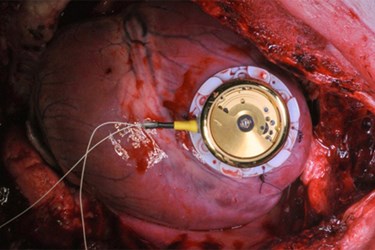Motion-Powered Pacemaker Runs Like Clockwork
By Chuck Seegert, Ph.D.

Similar to a self-winding watch, a new pacemaker has been designed that eliminates the need for batteries. Eventually, it may eliminate pacemaker leads, which have a propensity to break.
Cardiac pacemakers are relatively successful medical interventions that help a great number of patients worldwide, however, there are drawbacks to the technology.
“Batteries are a limiting factor in today’s medical implants,” said Adrian Zurbuchen, a Ph.D. candidate in the cardiovascular engineering group at the University of Bern, Switzerland, in a recent press release. “Once they reach a critically low energy level, physicians see themselves forced to replace a correctly functioning medical device in a surgical intervention. This is an unpleasant scenario which increases costs and the risk of complications for patients.”
The idea for the new design is based on the self-winding watch and was first proposed four years ago by professor Rolf Vogel, a cardiologist and engineer at the University of Bern, according to the press release. A commercially available wrist watch was used to develop the first prototype of the pacemaker. All extraneous parts were stripped away to reduce weight, and a custom housing was made that allowed it to be secured directly to the heart where the continuous motion of the muscles wind it.
“The heart seems to be a very promising energy source because its contractions are repetitive and present for 24 hours a day, 7 days a week. Furthermore the automatic clockwork, invented in the year 1777, has a good reputation as a reliable technology to scavenge energy from motion.” said Zurbuchen in the press release.
Winding the pacemaker tightens a mechanical spring, which spins a micro-generator to produce the electrical current. According to the press release, an electronic circuit then takes the energy and stores it as a buffer capacity, which is used thereafter to stimulate the heart.
Details of the research team’s work were presented at the European Society of Cardiologists annual meeting on August 31, 2014.
“Our new pacemaker tackles the two major disadvantages of today’s pacemakers. First, pacemaker leads are prone to fracture and can pose an imminent threat to the patient. And second, the lifetime of a pacemaker battery is limited. Our energy harvesting system is located directly on the heart and has the potential to avoid both disadvantages by providing the world with a batteryless and leadless pacemaker,” said Zurbuchen in the press release.
Using the heartbeat to power a pacemaker is an area of intense research and not just at the University of Bern. Teams in Ireland and Korea both have concepts under development that seek to capitalize on this novel source of power.
Image Credit: ESC
